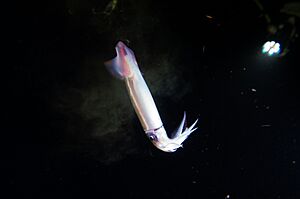Neon flying squid facts for kids
Quick facts for kids Neon flying squid |
|
|---|---|
 |
|
| An adult neon flying squid in the ʻAlenuihāhā Channel, Hawaii. | |
| Conservation status | |
| Scientific classification | |
| Synonyms | |
|
Species synonymy
Loligo bartramii
Lesueur, 1821 Loligo pironneauii Souleyet, 1852 Loligo touchardii Souleyet, 1852 Loligo vitreus Rang, 1835 in Férussac & D'Orbigny, 1834-1848 Ommastrephes caroli Furtado, 1887 Ommastrephes caroli stenobrachium Rancurel, 1976 Ommastrephes caroli stenodactyla Rancurel, 1976 Ommastrephes cylindraceus d'Orbigny, 1835 in 1834–1847 Ommatostrephes caroli Furtado, 1887 Onychoteuthis brevimanus Gould, 1852 Stenoteuthis bartrami (Lesueur, 1821) Sthenoteuthis bartramii (Lesueur, 1821) |
The neon flying squid (Ommastrephes bartramii) is a large squid that can "fly" out of the water! It is also known as the red flying squid, akaika, or red squid. You can find these amazing creatures in warm and mild parts of oceans all around the world. They belong to a family of squids called Ommastrephidae. Some squids in this group can even glow in the dark!
Contents
About the Neon Flying Squid
How Scientists Classify Squids
Scientists group living things into families. The neon flying squid belongs to the Ommastrephidae family. A French scientist named Charles Alexandre Lesueur first described this squid in 1821.
For a long time, scientists thought the neon flying squid was the only species in its group, called Ommastrephes. But a study in 2020 looked at the squid's DNA. It showed that there are actually four different types of neon flying squid! Because of this, three older names for squids were brought back. These are Ommastrephes brevimanus, Ommastrephes caroli, and Ommastrephes cylindraceus.
What Does a Neon Flying Squid Look Like?
Neon flying squids are easy to spot because they have a long, silver band. This band runs down the middle of their underside.
Male squids usually have a body length of about 29 to 32 centimeters (11 to 13 inches). They can grow up to 45 cm (18 in) long. Female squids are much bigger. They are usually around 50 cm (20 in) long, and the largest known female was 60 cm (24 in) long.

Their arms do not have wide flaps. They have many suckers on their arms, usually between 9 and 27 on the bottom row and 10 to 25 on the top row. The third pair of arms has special flaps that are wider than the arm itself. Another way to tell them apart is by the suckers on their feeding arms, called tentacular clubs. These suckers have small teeth. This helps tell them apart from other squids like the orangeback flying squid.
These squids have small, glowing spots called Photophores. These spots are found on the underside of their body, head, and tentacles. They do not have glowing spots inside their bodies.
Why Are They Called "Flying Squids"?
Like some other squids, neon flying squids are called "flying squids" because they can shoot out of the water. They are a bit like flying fishes. Sometimes, they even land on the decks of ships! This often happens when the weather is rough. It also happens when predators are nearby. Scientists think this is how they try to escape danger.
Squids have been seen staying in the air for a while, almost like real flight. Scientists are still trying to understand exactly how they do this. But it is a common sight, and there are even photos of neon flying squids flying!
Where Do Neon Flying Squids Live?
Neon flying squids live all over the world. You can find them in the warm and mild waters of the Pacific, Atlantic, and Indian Oceans. They are rarely seen in the Mediterranean Sea.
At night, they usually feed close to the surface, about 0 to 70 meters (0 to 230 feet) deep. They like areas where cold and warm water meet. During the day, they swim much deeper, usually between 300 to 700 meters (980 to 2,300 feet). They have even been found as deep as 1,490 meters (4,890 feet)! This daily up-and-down movement is called diel vertical migration. Many other ocean animals do this too.
Ecology and Biology
Life Cycle of the Neon Flying Squid
Neon flying squids travel long distances. They live for about one year. During this year, they travel between their feeding areas and their breeding grounds.
Mating happens when male squids pass sperm packets to the females. Males usually become ready to mate earlier in the season. Female squids store these packets until they are ready to lay eggs. Females lay eggs throughout the year, not just in one season. Each female can lay a huge number of eggs, from about 350,000 to 3.6 million! The number depends on her size. Both male and female squids are thought to die soon after they mate and lay eggs.
Baby squids, called hatchlings, are very tiny. They are only about 1 millimeter (0.04 inches) long when they hatch. They grow very quickly. After just one month, they can be 7 mm (0.28 in) long. These young squids travel north towards colder waters in the summer and autumn. They usually feed about 25 meters (82 feet) below the surface. As they grow up, they return to the breeding grounds to mate.
What Do They Eat and What Eats Them?
Neon flying squids eat small ocean fishes. These include lanternfishes and saury. They also eat other squids. Sometimes, they even eat smaller members of their own species!
Many animals hunt neon flying squids. Large fishes like swordfish, marlin, and tuna eat them. Sharks and marine mammals also prey on them. People also catch neon flying squids for food.



